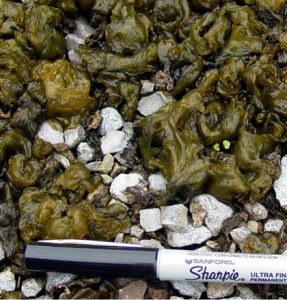
Nostoc algae on gravel
Photo credit: Purdue Plant and Pest Diagnostic Lab
Q. For the last few years we have noticed some green blobs on our gravel drive. It only grows in size when it rains and dries up and turns black when the weather is sunny. It looks like turkey droppings and feels like jelly when wet. It is very unsightly and gets tracked into the house. We never saw this stuff until the last few years and only on limestone gravel. It seems to grow and spread up and down the drive. Is this some kind of new land algae? Does it start and grow because of the lime from the gravel? This may not be your area of expertise, but if you know what this stuff is let me know and how to get rid of it. – D.V.
A. It sounds like it could be a terrestrial algae known as Nostoc, which can grow on stone, concrete, grave, and even on the lawn, especially on compacted turf. This algae stays dormant until the right conditions come along – warm moisture, and we’ve had plenty of that this summer! And the slimy blobs are more than just unsightly; they are really slippery, so they can be, especially on smooth surfaces such as patios and greenhouse floors. Anything you can do to aerate and dry the area will help control it, but there’s not much you can do about the rain. Copper sulfate may help knock it back, but control will be short-term, and unless conditions dry, the algae will return. Note that raking the algae may just help spread it around.
Additional info about Nostoc is available at Ohio State University Hort Shorts and Michigan State Extension’s Nostoc article.
Q. Can you tell me what kind of tree I have growing in the barnyard? It has several trunks about 3 feet off the ground. It has bark, like grape vine. It is shaped like an umbrella and about 10 feet tall. It has a lot of dead wood like a mock orange. Right now it has a little (hard to see) long narrow white flower – H.M.
A. I was thinking the shrub might be Physocarpus, more commonly known as ninebark, but it would have large clusters of small blossoms rather than a long narrow flower. A picture can say a thousand words, so the saying goes. You can bring a photo or, better yet, a live sample of a twig with leaves and flowers attached to your local county office of Purdue Extension. Contact information is at https://extension.purdue.edu/pages/CountyOffices.aspx. Or you can submit a photo or sample directly to the Purdue Plant and Pest Diagnostic Laboratory, www.ppdl.purdue.edu.